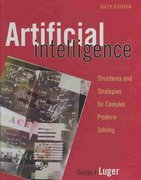Use the schema axioms presented in McCarthy (1980, Section 4) to create the circumscription results presented in
Question:
Use the schema axioms presented in McCarthy (1980, Section 4) to create the circumscription results presented in Section 9.1.3.
Data from section 9.1.3
In the previous sections, we extended logic by several different modal operators that were specifically designed to reason about the world as it usually is, relaxing the requirement that our knowledge of the world be somehow complete. These operators were born of the necessity of creating a more flexible and revisable view of the world. In this section we present logics designed specifically for two situations: first, to reason where a set of assertions specifies only those things that are true, and second, to reason where, because of the nature of a problem-solving task, sets of conjectures are usually true. In the first situation we use the closed world assumption and in the second circumscription. Both of these approaches to logic are often referred to as reasoning over minimal models.
We saw in Section 2.3 that a model is an interpretation that satisfies S, a set of predicate expressions, for all variable assignments. There are a number of ways of defining what is meant by a minimum model. We define a minimum model as a model such that there are no smaller models that can satisfy the set of expressions S for all variable assignments.
The idea that makes minimum models important for reasoning is this: there are a (potentially) infinite number of predicates that can be used to describe situations in the world. Consider, for example, the limitless predicates that can be used to describe the situation for the farmer-wolf-goat-cabbage problem (Section 3.5, Exercise 2): the boat is not slowly sinking, the river banks are close enough that rowing will get the boat across, the wind and current are not relevant factors, and so on. When we describe a problem we are usually quite parsimonious in our descriptions. We create only those predicates that are both relevant and needed to solve the problem.
The closed world assumption is based on this minimum model of the world. Exactly those predicates that are necessary for a solution are created. The closed world assumption effects the semantics of negation in reasoning. For example, if we wanted to determine whether a student is an enrolled member of a class, we could go to the enrolment database, and if the student is not explicitly listed in that database (the minimal model), he or she would not be enrolled. Similarly, if we wanted to know if two cities were directly connected by a plane flight, we would go to the listing of all airline connections. We would infer, if the direct flight is not listed there (the minimal model), that it does not exist.
The closed world assumption is a statement that if our computational system cannot conclude that p(X) is true, then not(p(X)) must be true. As we will see in Section 14.4, the closed world assumption supports Prolog inferencing. In Section 14.4 we see the three assumptions (axioms) implicit in the use of minimal models. These axioms are the unique name, i.e., that all atoms with distinct names are distinct; the closed world, i.e., the only instances of a relation are those implied by the clauses present; and domain closure. i.e., the atoms of the domain are exactly those of the model. When these three are satisfied, a minimum model becomes a full logic-based specification. If the axioms are not satisfied, some form of a truth maintenance algorithm is required.
If the closed world requires that all the predicates that make up a model be stated, circumscription (McCarthy 1980, Lifschitz 1984, McCarthy 1986) requires that only those predicates relevant to the problem solving are stated. In circumscription, axioms are added to a system that forces a minimal interpretation on the predicates of the knowledge base.
Step by Step Answer:

Artificial Intelligence Structures And Strategies For Complex Problem Solving
ISBN: 9780321545893
6th Edition
Authors: George Luger





